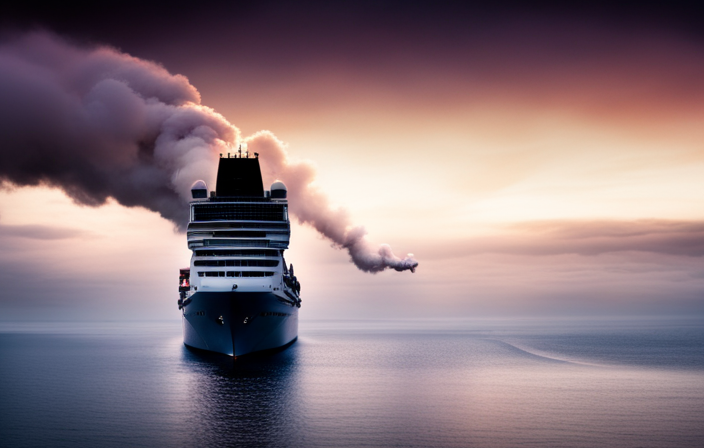Ever wondered about the massive engines that power those floating cities known as cruise ships? Brace yourself, as we’re diving into an investigation of how much fuel cruise ships consume.
When it comes to diesel usage, these behemoths of the sea are voracious consumers, guzzling thousands of gallons of fuel per day. But it’s not just a matter of how much diesel is burned – it’s also about the impact on the environment and the push for sustainable alternatives.
In this article, we’ll explore the factors that affect diesel consumption in cruise ships, the environmental consequences of their fuel use, and the innovative solutions that are being developed to improve fuel efficiency and explore alternative energy sources.
We’ll also discuss the role of regulations in reducing emissions, the importance of responsible tourism, and the economic impact of fuel costs on the cruise industry.
So, let’s set sail on this data-driven journey to uncover just how much diesel a cruise ship really uses.
Key Takeaways
- Cruise ships consume vast amounts of diesel fuel, making fuel efficiency technologies crucial for financial benefits.
- Factors such as ship size, speed, and itinerary affect the amount of diesel consumed by cruise ships.
- Diesel consumption in cruise ships has a significant environmental impact, releasing harmful pollutants.
- Innovations in fuel efficiency and alternative energy sources, such as LNG-powered ships and hybrid propulsion systems, are being explored to reduce diesel consumption and emissions.
The Importance of Fuel Efficiency in Cruise Ships
The importance of fuel efficiency in cruise ships cannot be overstated. Cruise ships consume vast amounts of diesel, and finding ways to reduce this consumption can result in significant financial benefits. Implementing fuel efficiency technologies such as advanced propulsion systems, hull design improvements, and waste heat recovery systems can greatly enhance a ship’s efficiency. These technologies optimize fuel consumption, reducing the amount of diesel needed to power the ship.
Cost saving measures like optimizing routing, reducing onboard energy consumption, and utilizing alternative fuels can further impact fuel efficiency. By adopting these strategies, cruise ships can make substantial savings on fuel costs and reduce their environmental impact. Understanding the factors affecting diesel consumption in cruise ships is vital to achieving these goals.
Factors Affecting Diesel Consumption in Cruise Ships
Factors affecting diesel consumption in cruise ships include ship size, speed, and itinerary. Larger ships consume more fuel due to their increased size and weight. Ships traveling at higher speeds require more fuel to maintain their velocity. The itinerary of the cruise ship can also affect fuel consumption, with ships sailing in rough seas or against strong currents expending more energy. To address these factors, cruise lines are implementing strategies for reducing diesel consumption. These strategies include optimizing ship design for better fuel efficiency, using advanced propulsion systems, and adopting alternative fuels. By implementing these strategies, cruise ships can minimize their environmental impact and reduce fuel consumption. Transitioning into the subsequent section about the environmental impact of cruise ship diesel consumption, it is crucial to assess the consequences of these factors.
Environmental Impact of Cruise Ship Diesel Consumption
When it comes to the environmental impact of cruise ship diesel consumption, it’s hard to ignore the significant consequences on our oceans and air quality.
The importance of emission control cannot be overstated, as the combustion of diesel fuel releases harmful pollutants such as sulfur dioxide, nitrogen oxides, and particulate matter. These pollutants have detrimental effects on marine ecosystems, leading to water pollution and the destruction of coral reefs.
Additionally, the emissions from cruise ship diesel engines contribute to air pollution, which can have serious health implications for both humans and wildlife.
To address these issues, innovations in fuel efficiency and alternative energy sources are being explored. Transitioning to cleaner fuels like liquefied natural gas (LNG) and implementing hybrid systems can significantly reduce the environmental impact of cruise ship diesel consumption.
By adopting these advancements, the cruise industry can move towards a more sustainable future.
Innovations in Fuel Efficiency and Alternative Energy Sources
When it comes to fuel efficiency and alternative energy sources in the cruise ship industry, two key innovations stand out: LNG-powered cruise ships and hybrid and electric propulsion systems.
LNG-powered cruise ships use liquefied natural gas as a cleaner and more efficient fuel, reducing emissions of greenhouse gases and other pollutants.
On the other hand, hybrid and electric propulsion systems combine traditional fuel sources with electric power, providing greater flexibility and reducing fuel consumption.
These innovations are crucial in addressing the environmental impact of cruise ship operations and moving towards a more sustainable future.
LNG-Powered Cruise Ships
LNG-powered cruise ships, like the world-famous AIDAnova, offer a cleaner and more sustainable way to enjoy a luxurious vacation at sea. These ships run on liquefied natural gas (LNG), which significantly reduces their environmental impact compared to traditional diesel-powered vessels.
The advantages of LNG-powered ships are evident in their lower emissions of sulfur dioxide, nitrogen oxides, and particulate matter, leading to improved air quality and a reduced carbon footprint. Additionally, LNG is readily available and has a lower price compared to marine diesel fuel.
However, there are also some disadvantages to consider. The initial investment for LNG-powered ships is higher, and the infrastructure for LNG refueling is still limited.
Despite these challenges, the industry continues to explore and develop hybrid and electric propulsion systems as the next step towards achieving even greater fuel efficiency and sustainability.
Hybrid and Electric Propulsion Systems
To fully enjoy what you’re reading, let’s explore the truth behind the theory of hybrid and electric propulsion systems on cruise ships. Hybrid propulsion systems combine traditional diesel engines with electric propulsion technology, offering significant fuel savings and reduced emissions. These systems use battery power during low-demand periods, such as when the ship is in port, and switch to diesel power during high-demand periods, like when cruising at high speeds. The electric propulsion technology allows for quieter operation and smoother sailing, enhancing the overall guest experience.
To give you a better understanding of the benefits, here is a table showcasing the fuel savings and emission reductions achieved by hybrid propulsion systems compared to traditional diesel engines:
| Fuel Savings | Emission Reduction | |
|---|---|---|
| Hybrid | Up to 20% | Up to 30% |
| Traditional | – | – |
These numbers highlight the significant improvements that hybrid propulsion systems bring to the table. Now, let’s transition into the subsequent section about the role of regulations in reducing cruise ship emissions.
The Role of Regulations in Reducing Cruise Ship Emissions
Regulations play a crucial role in curbing cruise ship emissions, making a significant impact on reducing environmental harm. To achieve this, regulatory policies are implemented to establish emission standards that cruise ships must comply with.
These standards set limits on the amount of pollutants, such as nitrogen oxides and sulfur oxides, that can be emitted by cruise ship engines. Compliance with these regulations ensures that cruise ships operate in an environmentally responsible manner, minimizing their impact on air quality and marine ecosystems.
Additionally, regulations also promote the use of cleaner fuels and technologies, such as exhaust gas cleaning systems and shore power connections, further reducing emissions.
As a result, these regulatory measures pave the way for a more sustainable future of cruising, where environmental concerns are addressed and mitigated effectively.
The Future of Sustainable Cruising
Transition: Now that we have explored the role of regulations in reducing cruise ship emissions, let’s delve into the future of sustainable cruising. As the demand for responsible tourism continues to grow, the cruise industry is striving to innovate and implement sustainable practices to minimize its environmental impact. From adopting advanced technologies to exploring alternative fuels, cruise companies are actively seeking ways to reduce their carbon footprint. One area of focus is the development of cleaner propulsion systems, such as hybrid engines and liquefied natural gas (LNG) power. These innovations aim to significantly decrease greenhouse gas emissions and improve energy efficiency. Additionally, the use of advanced waste management systems and the integration of renewable energy sources onboard are being explored. The future of sustainable cruising looks promising, with ongoing efforts to ensure a more environmentally friendly and enjoyable travel experience. Moving forward, let’s now explore how the cruise industry can promote responsible tourism.
Promoting Responsible Tourism in the Cruise Industry
Promoting responsible tourism in the cruise industry involves addressing key issues such as shore power and port infrastructure.
By implementing shore power systems, cruise ships can reduce their reliance on diesel fuel while docked, resulting in significant emissions reductions.
Additionally, investing in sustainable excursion options allows passengers to engage in environmentally-friendly activities that minimize the impact on local ecosystems and communities.
These measures help to create a more sustainable and responsible cruise industry that prioritizes environmental conservation and community well-being.
Shore Power and Port Infrastructure
Shore power, also known as cold ironing, allows cruise ships to connect to the local power grid and use electricity from the shore instead of running their engines. This not only reduces air pollution but also saves fuel costs for the cruise line.
To support the implementation of shore power, port infrastructure development is crucial. Ports need to invest in the necessary equipment, such as high-voltage substations and electrical connection points, to accommodate the power demand of large cruise ships. Additionally, retrofitting existing docks and terminals may be required to ensure compatibility with shore power systems.
By investing in shore power and port infrastructure, the cruise industry can significantly reduce its environmental impact while ensuring a comfortable and enjoyable experience for passengers. Transitioning to sustainable excursion options is the next logical step in promoting responsible tourism.
Sustainable Excursion Options
When you’re planning your vacation, it’s exciting to consider the sustainable excursion options available to you.
Cruise ships are increasingly offering eco-friendly alternatives to traditional excursions, allowing passengers to explore destinations while minimizing their environmental impact. These sustainable cruise options include activities such as snorkeling in protected marine areas, hiking through national parks, and participating in community-based tourism initiatives.
These excursions are designed to educate passengers about the local environment and culture, while also supporting conservation efforts and local communities. By choosing these eco-friendly excursion alternatives, passengers can contribute to the sustainability of the destinations they visit. This not only benefits the environment but also enhances the overall experience of the cruise.
Transitioning into the subsequent section about public perception and consumer demand for sustainable cruising, it is clear that passengers are increasingly seeking out these sustainable options in response to growing concerns about environmental issues.
Public Perception and Consumer Demand for Sustainable Cruising
Passengers are increasingly demanding more sustainable cruising options, driven by a growing public perception that prioritizes environmental responsibility. This shift in public awareness has led to a change in consumer behavior, with travelers seeking out cruise companies that demonstrate a commitment to sustainability.
The demand for sustainable cruising is evident in the following ways:
- Increased interest in shore excursions that focus on eco-friendly activities such as wildlife conservation and cultural immersion.
- Growing popularity of cruise lines that utilize advanced technologies to reduce fuel consumption and emissions.
- Rising demand for sustainable amenities and services onboard, including eco-friendly dining options and waste management practices.
These trends reflect a broader shift towards responsible tourism and a desire to minimize the environmental impact of cruising. As passengers become more conscious of their choices, cruise companies are recognizing the need to adapt and cater to this demand.
Transitioning into the subsequent section about the economic impact of fuel costs on the cruise industry, it is clear that sustainability is not only a consumer-driven priority but also a crucial factor in the industry’s financial considerations.
The Economic Impact of Fuel Costs on the Cruise Industry
The soaring fuel prices have significantly impacted the financial stability of the cruise industry. With fuel costs comprising a significant portion of a cruise ship’s operating expenses, fluctuations in fuel prices can have a substantial impact on the industry’s profitability.
The cruise industry is highly sensitive to changes in fuel prices, as it relies heavily on diesel fuel for propulsion and power generation. As fuel prices continue to rise, cruise lines are faced with the challenge of finding ways to reduce their carbon footprint while remaining economically viable.
Many cruise companies have invested in technologies and practices aimed at improving fuel efficiency and reducing emissions. These efforts not only help to mitigate the environmental impact of cruising but also contribute to cost savings in the long run.
Transitioning to a more sustainable model is essential for the cruise industry to balance luxury and sustainability in the face of fuel price fluctuations.
Conclusion: Balancing Luxury and Sustainability in the Cruise Industry
As we have explored the economic impact of fuel costs on the cruise industry, it is clear that finding a balance between luxury and sustainability is crucial. In this regard, the current subtopic focuses on the conclusion drawn from our analysis.
The cruise industry faces the challenge of meeting the growing demand for luxury experiences while also addressing the increasing importance of responsible tourism and consumer demand for sustainable practices.
To paint a picture for the audience, it is important to highlight two key aspects:
-
Balancing luxury and sustainability:
- Implementing energy-efficient technologies to reduce fuel consumption.
- Incorporating sustainable materials and practices in ship design and operations.
-
Responsible tourism and consumer demand:
- Offering eco-friendly shore excursions that promote conservation and cultural awareness.
- Providing transparent information on sustainability initiatives to engage and educate consumers.
By navigating these challenges, the cruise industry can thrive while minimizing its environmental footprint and meeting the evolving expectations of conscious travelers.
Frequently Asked Questions
How is the diesel consumption of a cruise ship measured and monitored?
To measure and monitor diesel consumption on a cruise ship, various techniques are employed. These include fuel flow meters, engine performance monitoring systems, and regular fuel consumption audits. By employing these methods, accurate data on diesel consumption can be obtained and analyzed.
What are the main challenges faced by cruise ships in implementing fuel efficiency measures?
The main challenges faced by cruise ships in implementing fuel efficiency measures are technological limitations, high initial costs, and the need for significant infrastructure upgrades. These factors hinder the adoption of more fuel-efficient technologies and practices.
Are there any specific technologies or practices that can help reduce diesel consumption in cruise ships?
Technological advancements and sustainable practices can significantly reduce diesel consumption in cruise ships. Innovative propulsion systems, such as hybrid or LNG engines, combined with energy-efficient designs and onboard waste management systems, offer potential solutions.
How do cruise ship emissions compare to other sources of pollution in the marine environment?
Cruise ship emissions have a significant impact on marine ecosystems compared to other sources of pollution. The high levels of pollutants released, such as sulfur dioxide and nitrogen oxides, contribute to air pollution and ocean acidification, harming marine life and ecosystems.
What are the potential alternatives to diesel fuel for powering cruise ships in the future?
In the future, potential alternatives for powering cruise ships include liquefied natural gas (LNG), hydrogen fuel cells, and battery technology. These alternatives show promise for future implementation, offering reduced emissions and environmental benefits.
Does the Fuel Capacity of a Cruise Ship Determine the Amount of Diesel it Uses?
The fuel capacity of cruise ships plays a significant role in determining the amount of diesel they use. Ships with larger fuel capacities can travel longer distances without refueling, but they also consume more fuel overall. Efficiency measures can help mitigate the impact of a larger fuel capacity on diesel usage.
Conclusion
In conclusion, the cruise industry is making strides towards achieving a balance between luxury and sustainability.
With the average cruise ship consuming approximately 80,000 gallons of diesel fuel per day, it becomes evident that fuel efficiency is of utmost importance.
However, it is fascinating to note that innovative technologies and alternative energy sources have the potential to reduce fuel consumption by up to 20%.
This statistic emphasizes the significance of investing in research and development to ensure a greener future for the cruise industry, benefiting both the environment and the economy.
Meet Asra, a talented and adventurous writer who infuses her passion for exploration into every word she writes. Asra’s love for storytelling and her insatiable curiosity about the world make her an invaluable asset to the Voyager Info team.
From a young age, Asra was drawn to the power of words and their ability to transport readers to far-off lands and magical realms. Her fascination with travel and cultures from around the globe fueled her desire to become a travel writer, and she set out on a journey to turn her dreams into reality.











